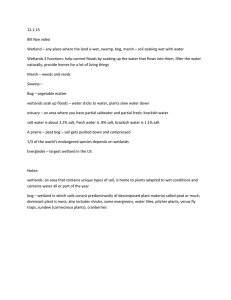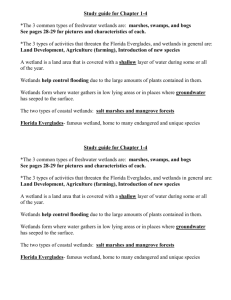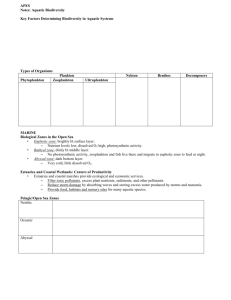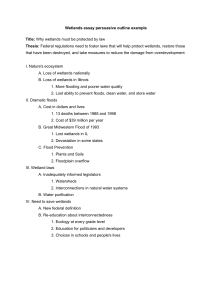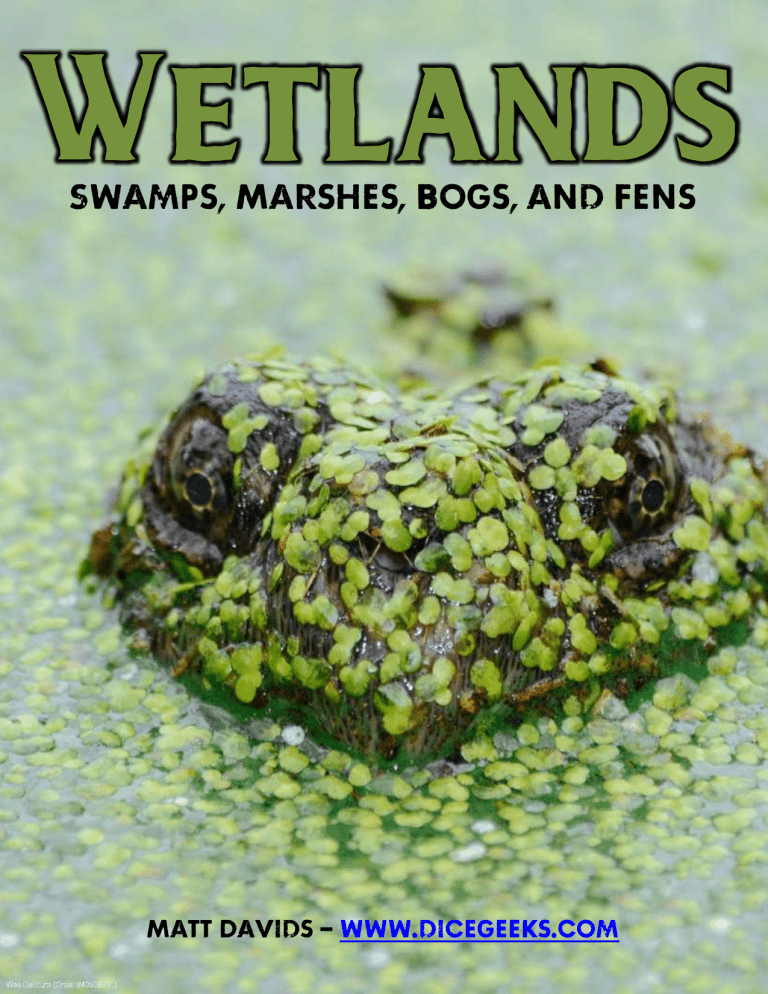
Wetlands Swamps, Marshes, Bogs, and Fens Matt Davids – www.dicegeeks.com Wes Delirium (Order #40508331) Why Use Wetlands in Your RPG Campaigns? There are many reasons to use wetlands in your campaigns. Here are just a few: Break up long journeys Get your party out of the woods or mountains Add a touch of realism Unique challenges based on the landscape Wetlands can provide new quests for players as well. Some ideas: Capture swamp gas for a wizard Gather peat for fuel Find a specific kind of moss for a spell Collect specific insects for a potion Gather bog wood for a local merchant Wetlands can allow GM’s to add unique and strange places. A few thoughts: The Bog of Loathing Wes Delirium (Order #40508331) The Marsh of Sorrow The Fen of Despair The Swamp of the Lost The Marsh of Forgetfulness The Bog of the Dead The Fire Swamps (I couldn’t resist) This guide will discuss the basics elements of wetlands to help get your creativity flowing. Wetlands Not many natural terrains are more diverse than wetlands. Wetlands contain a multiplicity of vegetation and wildlife. These ecosystems team with insects, amphibians, turtles, and birds of all types. The variety of the flora is astonishing. Mosses, lichens, trees, bushes, shrubs, peat, ferns, reeds, and grasses, just to name a few, can all be found in wetlands. When constructing your campaigns, introducing wetlands can create unique experiences and challenges for characters. When traveling on their quest, an adventuring party will invariably come across wetlands. Or least, they would if they were traveling in the real world. Use wetlands to diversify the types of terrains in your campaigns. A welldescribed and presented wetland can create a memory that will last a lifetime. Of course, not all wetlands are the same. Wes Delirium (Order #40508331) This guide will explore the different types of wetlands in enough detail to give game masters the tools they need to describe these wonderful places to their players. There are four main types of wetlands we will explore: swamps, marshes, bogs, and fens. The four different types of wetlands provide many fascinating adventure opportunities. Any one of them can provide hours of fun and a great backdrop for exploits for new and experienced role players alike. This guide will cover several other topics like, types of water in wetlands, how to weave in magic, and more. Swamps By definition swamps are wetlands with wooded vegetation and trees. Swamps appear to be ancient things. They look as though they've come from a different time or different age. Like something out the beginning of time or even the beginning of the world. Create a dismal and depressing landscape. Include details like the canopy, which creates a dark and eerie color over the entire swamp. Wes Delirium (Order #40508331) Tree moss hanging from knobby-kneed cypresses nearly touches the scumcovered water. Mist clouds visibility. Dampness and humidity cling to travelers, turning their clothes into uncomfortable sacks. The water in a swamp can be shallow or deep. Both are treacherous to any who dare to travel in these parts. Boats with paddles can maneuver swamps fairly well. However, the boats must have a very narrow draw. A boat with a deep keel is in danger of running aground at any moment, because the depth of the water can change from 15 feet to 3 inches in a matter of yards. Swamp of the Lost Effects: For every hour spent in the swamp there is a chance a character’s mind becomes clouded and confused. Scenario #1: A wizard hires the party to capture swamp gas. He needs it for experiments that will lead the party to gain knowledge for a larger quest. Scenario #2: The party wanders into the swamp unknowingly. They can recognize the swamp is having strange effects on them by rolling. Possible Encounters: Giant Carnivorous Plants Ghosts Lost People Poisonous Fumes Swamp Monster Paths and channels through the swamp can suddenly turn into dead ends trapping any would-be adventurer. Dangers lurk everywhere. Snakes above and in the water, either poisonous vipers or giant constrictors, menace anyone traveling through the swamp. Under the water lurk the most terrible foes: crocodiles, alligators, giant snapping turtles with beaks that can Wes Delirium (Order #40508331) crush men's bones. Giant catfish, hunting and prowling, can drag a man beneath the water. Certain ground gives the illusion of being solid, yet when stepped upon, gives way beneath the slightest weight. Great herons and other waterfowl pick their way among the shadows and pools of light. Vines and weeds dangle and entrap. An endless maze of water and leaves and thickets are overshadowed by giant cypresses and other swamp trees. A melancholy place indeed. Only the greatest need drives travelers here. Pepper your swamp with encounters fitting the setting. Overgrown cottages, boats filled with moss floating aimlessly, ancient graves, shipwrecks, hidden treasure; remnants of strange rituals, bloody clothing, lost people and much more are possible. Marshes Marshes are typified by grasses and contain little or no wooded vegetation or trees. They can stretch for mile upon endless mile. The grasses form a confounding maze in which visibility becomes difficult. Some of the grass can reach 10 to 12 feet in height above the surface of the water. Wes Delirium (Order #40508331) Marsh of Sorrow Effects: Every day spent in the marsh increases the chance of a character being lost in sorrow and hopelessness. Quests are considered impossible, journeys too difficult, etc. Scenario #1: The party must cross the marshes to complete their quest. However, they receive many warnings about traveling there. Possible Encounters: Ghosts Ruins with Sad Inscriptions Grass Funeral Rafts The water is seldom deep. Eight feet would be deep with the average being much less. Marshes can be sunny places teeming with ducks, geese, swans, and herons all feeding on minnows and fish. In the southern latitudes, alligators will make their homes in marshes, and manatees will come up from the sea to feed on grass. Towns and villages near marshes exploit the variety of flora and fauna. Traveling through a marsh can be arduous. The travelers would be constantly soaked, and a raft or flat-bottomed boat would be a godsend. Any party journeying near rivers is likely to cross marshes. Use them to their full affect. A party could use a marsh to hunt and collect fresh water after a long trek. A marsh could be another obstacle on the way to finish a quest. If the adventurers want to build a raft, grass will be their main option unless they carry large amounts of wood with them. The travelers are likely to come across old fishing shacks, sunken boats, ruins of towns that have been reclaimed by the landscape, duck blinds, and much more. Wes Delirium (Order #40508331) Bogs The Peat Gatherers In northern latitudes, bogs can be filled with layers upon layers of peat and are sometimes called mires, quagmires, or muskegs. Situation: A group of orcs and goblins have enslaved a human town. They are forcing the townspeople the gather peat for their infernal furnaces. Peat is decayed plant matter that has accumulated over many hundreds or thousands of years. Scenario #1: The party wanders into the bog unknowingly. The characters hear tales of sorrow and see abuse of prisoners. Bogs are home to very specific types of mosses, small carnivorous plants, and highly specialized insects. On cold mornings, thick mists rise from the heat of the decaying plants and peat. Scenario #2: The party is enslaved and forced to work in the bog. Possible Encounters: Guards Orc Chieftain Goblin Wizard Slave Child No trees are found in bogs. Only remnants of long-dead forests called “bog wood” appear occasionally. Bogs are home to cranberries, blueberries, and huckleberries. Flies and butterflies of very peculiar types live and flourish in these places. Also, a large variety of salamanders are found among the mosses. Communities near bogs cultivate the berries and use peat for cooking and heating fuel. Bog wood makes excellent and prized furniture. Traveling through bogs is grueling and saps the strength from even the Wes Delirium (Order #40508331) mightiest adventurers. Patches of open water mix with mounds of peat. Floating mats of moss can give the illusion of solid ground. When faced with crossing a bog, the most stouthearted adventurer can feel weakness enter his knees. Fens While similar to a bog, a fen has less peat and more small wooded vegetation. A particular kind of mire, fens are found mainly in northern climates. However some can exist in tropical climes. The fen Spirit Situation: The ghost of an ancient elf princess haunts a lonely fen. Scenario #1: The party needs information from the ghost. They must discover her secret and help her in some way. Scenario #2: The party needs an ingredient that grows only in the fen. It is needed to make a medicine to the save the life of an NPC close to the party. The ghost must be convinced to allow them to have it. Possible Encounters: Quick Sand Wolves Poison Thorns Wes Delirium (Order #40508331) The ground is saturated with water and shrubs and small trees dominate the landscape. Sometimes a fen is overtaken with willow or alder. The types of vegetation and animal life found in fens are very specific to the ecosystem. Flies and other insects are the main types of animal life. Standing water comes only in puddles and pools. However a traveler’s feet will sink deep into the soft earth. Traveling through a fen is torturous work. Water Types Freshwater – Wetlands can contain freshwater, which is very helpful to travelers. Brackish – A mixture of fresh and salt water can tempt a parched wanderer to drink, but he will do so at his peril. Saltwater – Saltwater provides the added danger of no drinkable water nearby. Water Source Classification Palustrine Wetlands – An inland wetland that lacks a source of flowing water and is precipitation fed. Marine Wetlands – This type of wetland is exposed to the open ocean. Estuarine Wetlands – The mixing of fresh and saltwater sets this type of wetland apart. Riverine Wetlands – This type of wetland is associated with rivers and flowing water. Lacustrine Wetlands – Wetlands connected to the ecosystem of lakes or bodies of freshwater. Wes Delirium (Order #40508331) Mosquitoes Do not forget mosquitoes. They plague anyone in wetlands. In the north, they do so only in certain seasons. In the south, it is a nearly year-round scourge. In the great bogs of Siberia, for a couple months of the year, millions upon millions of mosquitoes emerge. They form clouds. They plug travelers’ noses and get crushed by their blinking. Something valuable must lie at the end of the journey for an adventurer to endure this trial. Use them to create a fuller environment for your players. Let them know that the journey has a price to be paid. Also, remember that mosquitoes carry diseases: Malaria, Dengue, Yellow Fever, and West Nile just to name a few. Of course as game master, you can create a variety of fictional diseases. Mixing in the Supernatural or Magic Any reader of fantasy knows Tolkien’s Dead Marshes. The dead lying in repose beneath the murky water, haunting any travelers who dare tread its winding paths. Think of similar ideas for your campaigns. Wes Delirium (Order #40508331) If a bizarre evil awaits the party, as the adventurers get closer to their goal, the landscape should get stranger and stranger. The swamp near the wizard’s tower is now filled monstrosities from his twisted experiments. Two hundred years ago, a warlord used slaves to harvest peat from giant bogs to fuel his war machine. Now the souls of those slaves haunt the bogs. A large tract of fens serves as a barrier to an elven stronghold. A once great city cursed by a wizard has sunk into the mud and become a maze-like marsh. Conclusion Wetlands in RPG campaigns are usually highly underused. Possibly a swamp pops up here and there in some spooky horror campaign, but not much else. Many great cities are located at the mouth of rivers where they pour into the sea. These are all great places to put a marsh or bog or swamp or fen. When traveling through great tracts of wilderness in northern lands, where many fantasy RPGs are set, an adventuring party is certain to come across a fen or a bog. Create instant challenges based solely upon the terrain. The part of the fun can be slogging through a wetland only to arrive at the town mud-covered and exhausted. Or your party reaches the dungeon spent. Their clothes tattered and you know more challenges lie ahead. Wes Delirium (Order #40508331) Wetlands Resource List Wetlands: https://en.wikipedia.org/wiki/Wetland Swamps: https://en.wikipedia.org/wiki/Swamp Bogs: https://en.wikipedia.org/wiki/Bog Marshes: https://en.wikipedia.org/wiki/Marsh Fens: https://en.wikipedia.org/wiki/Fen A More Detailed Classification: https://www.epa.gov/wetlands/wetlandsclassification-and-types#marshes List of Major Swamps: https://en.wikipedia.org/wiki/Swamp#List_of_major_swamps Support dicegeeks on Patreon! Explore Dicegeeks Resources and RPGs at DriveThruRPG.com Wes Delirium (Order #40508331) Dicegeeks Twitter - @dicegeeks Dicegeeks Monthly RPG Newsletter: http://eepurl.com/bINBh5 www.dicegeeks.com Wes Delirium (Order #40508331)
